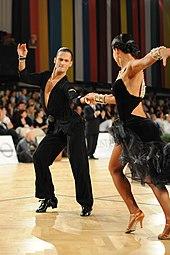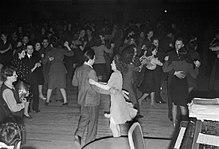The jive is a dance style that originated in the United States from African-Americans in the early 1930s. The name of the dance, jive, comes from the name of a form of African-American Vernacular slang, popularized in the 1930s by the publication of a dictionary by Cab Calloway, the famous jazz bandleader and singer.[1] In competition ballroom dancing, the jive is often grouped with the latin-inspired ballroom dances, though its roots are based on swing dancing and not latin dancing.
History
To the players of swing music in the 1930s and 1940s "Jive" was an expression denoting glib or foolish talk.[2]
American soldiers brought Lindy Hop/Jitterbug to Europe around 1940, where this dance swiftly found a following among the young. In the United States the term Swing became the most common word used to describe the dance, and the term "jive" was adopted in the UK. Variations in technique led to styles such as boogie-woogie and swing boogie, with "jive" gradually emerging as the generic term in the UK.[3]
After the war, the boogie became the dominant form for popular music. It was, however, never far from criticism as a foreign, vulgar dance. The famous ballroom dancing guru, Alex Moore, said that he had "never seen anything uglier". In 1968 it was adopted as the fifth Latin dance in International competitions. The modern form of ballroom jive in the 1990s–present, is a very happy and boppy dance, the lifting of knees and the bending or rocking of the hips often occurs.
As a contemporary dancesport
Today, the Jive is one of the five International Latin dances. In competition it is danced at a speed of 176 beats per minute, although in some cases this is reduced to between 128 and 160 beats per minute.
Many of its basic patterns are similar to these of the East Coast Swing with the major difference of highly syncopated rhythm of the Triple Steps (Chasses), which use straight eighths in Jive and hard swing in ECS.
References
- ^ Sorene, Paul (2017-04-26). "Cab Calloway's Hepster's Dictionary: A Guide To The Language Of Jive (1938)". Flashbak. Retrieved 2020-08-02.
- ^ Early Jazz: Its Roots and Musical Development. by Gunther Schuller. 1968. Oxford University Press. page 379. ISBN 0-19-504043-0
- ^ Paul Bottomer. 1997. Black Dog & Leventhal. page 157. ISBN 1-57912-049-0

